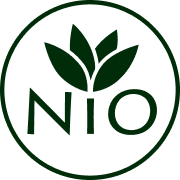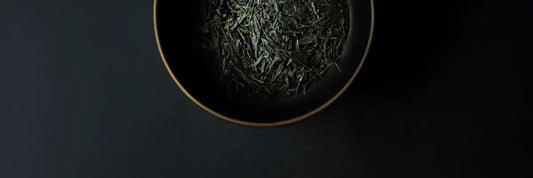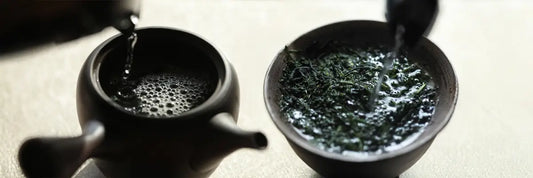Gyokuro powder is something often compared with matcha powder, but there is a small difference between the two.
In this article, we are going to explore gyokuro and see what makes gyokuro green tea powder different from matcha powder.
Let’s get started! 🍵🌱

What is gyokuro powder?
To understand gyokuro green tea powder, you first have to understand gyokuro vs matcha.
Matcha powder is made from tencha leaves, while gyokuro powder is made from gyokuro tea leaves.
Let’s briefly walk through the production process of these two teas so you can see the similarities and differences between gyokuro powder vs matcha.
How is gyokuro powder made
To be considered gyokuro, the gyokuro plant needs to be shaded for 3 weeks before the harvest in order to develop this sweet and savory flavor. Then, the farmer will select the top 3 leaves and process them immediately after harvesting.
Like most Japanese green teas, gyokuro tea is steamed in order to stop the oxidation process and lock in the green colors and flavors of the leaves. After the steaming process is complete, the leaves are then dried and rolled. To get these tight needle-shaped leaves, gyokuro leaves are taken through an additional rolling process which requires an extra machine.
How is matcha made
Like gyokuro, matcha is also made from tea plants that have been shaded for 3 weeks before the harvest. The top 3–5 sprouts of the tea plant are selected and later processed. This is where the difference between matcha and gyokuro tea powder arises.
The stems and leaves of the tea need to be separated before it is ground into premium, ceremonial grade matcha. Once the stems have been removed, the tea is referred to as “tencha” and it is one step away from becoming matcha. All that needs to happen is for the tencha leaves to be ground into an extremely fine powder in a large granite mill.
Understanding the matcha powder production
Are you interested in learning the complete production process of matcha? Then we have the right article for you! Check out 👉 How is Matcha Made?
The difference between gyokuro powder and matcha powder
So what’s the difference between gyokuro powder vs matcha? You’d be forgiven for confusing the two. These two teas are very similar but they have key differences when it comes to production, taste and caffeine levels.
Matcha has its stems removed
Unlike gyokuro, matcha green tea powder has to have its stems removed during the production process.
The main difference between gyokuro vs tencha is that tencha has its stems removed. Once the stems are removed, the tea is considered to be tencha and is one step away from becoming matcha.
This is the key difference between the two teas. The stems are removed during the production process in order to smooth out the flavor, so the flavor of gyokuro tea powder may not be quite as smooth as matcha, although it can still be very delicious.
Gyokuro tea powder has a slightly lower caffeine content
Gyokuro caffeine level is slightly lower due to the presence of stems.
The tea plant produces caffeine as a defense mechanism to protect itself against insects.
The younger, more tender sprouts used to make gyokuro and matcha will produce more caffeine as they need more protection.
As the stems are tougher than the leaves, they will only produce about ⅓ the caffeine compared to the leaves, and this is the main difference between gyokuro powder vs matcha.
Unlike gyokuro, matcha green tea powder has these stems removed and as a result, gram for gram, matcha powder has the most caffeine of any tea.
This is not to say that a cup of gyokuro will have more caffeine than a cup of matcha, as gyokuro is typically prepared with 5 grams of leaves and matcha is prepared with 2 grams of powder.

The flavor of gyokuro green tea powder
There is a slight difference in the flavor of gyokuro powder when compared to its more famous counterpart.
Gyokuro is all about maximizing this savory or umami flavor, and this translates into the gyokuro powder as well.
Also, the additional stems can sometimes produce a floral taste characteristic, which is more rare in matcha.
The result is a gyokuro powder that is a bit more bold, savory and floral when compared to a standard matcha.
The benefits of choosing gyokuro organic green tea powder
We only offer gyokuro organic green tea powder on our website, and there is a good reason for it. When you drink powdered tea, you’re drinking the entire leaf along with everything that was put into it.
That’s why it’s especially important to select a gyokuro organic green tea powder, like the ones produced by Mr. Sakamoto. It is especially difficult to produce gyokuro without the use of pesticides or chemical fertilizers, but Mr. Sakamoto has found a way to produce strong, flavorful tea plants without harming the environment, and we are so grateful to work with him.
Bonus question 🍃
Do you know what the teas with the highest and lowest caffeine level are? We wrote two articles in which we’re covering all the details about the caffeine level of each tea. Make sure to read our articles:




